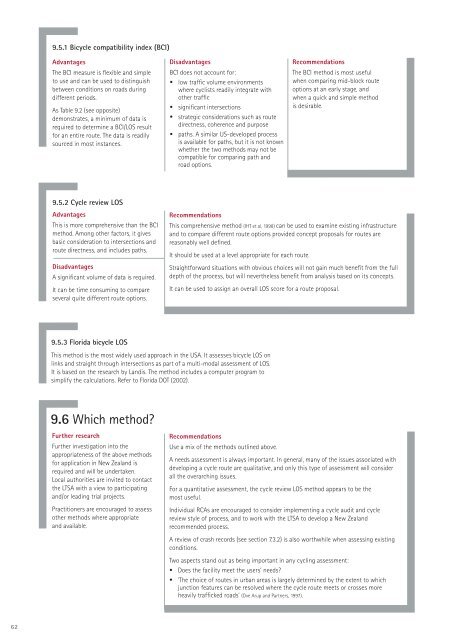Cycle network and route planning guide - NZ Transport Agency
Cycle network and route planning guide - NZ Transport Agency
Cycle network and route planning guide - NZ Transport Agency
Create successful ePaper yourself
Turn your PDF publications into a flip-book with our unique Google optimized e-Paper software.
9.5.1 Bicycle compatibility index (BCI)<br />
Advantages<br />
The BCI measure is flexible <strong>and</strong> simple<br />
to use <strong>and</strong> can be used to distinguish<br />
between conditions on roads during<br />
different periods.<br />
As Table 9.2 (see opposite)<br />
demonstrates, a minimum of data is<br />
required to determine a BCI/LOS result<br />
for an entire <strong>route</strong>. The data is readily<br />
sourced in most instances.<br />
Disadvantages<br />
BCI does not account for:<br />
• low traffic volume environments<br />
where cyclists readily integrate with<br />
other traffic<br />
• significant intersections<br />
• strategic considerations such as <strong>route</strong><br />
directness, coherence <strong>and</strong> purpose<br />
• paths. A similar US-developed process<br />
is available for paths, but it is not known<br />
whether the two methods may not be<br />
compatible for comparing path <strong>and</strong><br />
road options.<br />
Recommendations<br />
The BCI method is most useful<br />
when comparing mid-block <strong>route</strong><br />
options at an early stage, <strong>and</strong><br />
when a quick <strong>and</strong> simple method<br />
is desirable.<br />
9.5.2 <strong>Cycle</strong> review LOS<br />
Advantages<br />
This is more comprehensive than the BCI<br />
method. Among other factors, it gives<br />
basic consideration to intersections <strong>and</strong><br />
<strong>route</strong> directness, <strong>and</strong> includes paths.<br />
Disadvantages<br />
A significant volume of data is required.<br />
It can be time consuming to compare<br />
several quite different <strong>route</strong> options.<br />
Recommendations<br />
This comprehensive method (IHT et al, 1998) can be used to examine existing infrastructure<br />
<strong>and</strong> to compare different <strong>route</strong> options provided concept proposals for <strong>route</strong>s are<br />
reasonably well defined.<br />
It should be used at a level appropriate for each <strong>route</strong>.<br />
Straightforward situations with obvious choices will not gain much benefit from the full<br />
depth of the process, but will nevertheless benefit from analysis based on its concepts.<br />
It can be used to assign an overall LOS score for a <strong>route</strong> proposal.<br />
9.5.3 Florida bicycle LOS<br />
This method is the most widely used approach in the USA. It assesses bicycle LOS on<br />
links <strong>and</strong> straight through intersections as part of a multi-modal assessment of LOS.<br />
It is based on the research by L<strong>and</strong>is. The method includes a computer program to<br />
simplify the calculations. Refer to Florida DOT (2002).<br />
9.6 Which method?<br />
Further research<br />
Further investigation into the<br />
appropriateness of the above methods<br />
for application in New Zeal<strong>and</strong> is<br />
required <strong>and</strong> will be undertaken.<br />
Local authorities are invited to contact<br />
the LTSA with a view to participating<br />
<strong>and</strong>/or leading trial projects.<br />
Practitioners are encouraged to assess<br />
other methods where appropriate<br />
<strong>and</strong> available.<br />
Recommendations<br />
Use a mix of the methods outlined above.<br />
A needs assessment is always important. In general, many of the issues associated with<br />
developing a cycle <strong>route</strong> are qualitative, <strong>and</strong> only this type of assessment will consider<br />
all the overarching issues.<br />
For a quantitative assessment, the cycle review LOS method appears to be the<br />
most useful.<br />
Individual RCAs are encouraged to consider implementing a cycle audit <strong>and</strong> cycle<br />
review style of process, <strong>and</strong> to work with the LTSA to develop a New Zeal<strong>and</strong><br />
recommended process.<br />
A review of crash records (see section 7.3.2) is also worthwhile when assessing existing<br />
conditions.<br />
Two aspects st<strong>and</strong> out as being important in any cycling assessment:<br />
• Does the facility meet the users’ needs?<br />
• ‘The choice of <strong>route</strong>s in urban areas is largely determined by the extent to which<br />
junction features can be resolved where the cycle <strong>route</strong> meets or crosses more<br />
heavily trafficked roads’ (Ove Arup <strong>and</strong> Partners, 1997).<br />
62

















